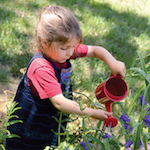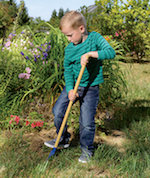
"In today's world, we all need to get outside and grow and do these things together, and a garden is the best place to teach our children about healthy food choices and to also find joy."
—Emily Murphy, Grow What You Love
 The joy of discovery lights up the world. It's a special delight to see children discovering their environment. We may have explained to them how plants grow or where carrots come from, taking for granted that they will connect this knowledge to the living plants around them. But, to truly teach children about the world in which they live, there's nothing like learning from the ground up - digging in the dirt, planting seeds, and growing things you can eat.
The joy of discovery lights up the world. It's a special delight to see children discovering their environment. We may have explained to them how plants grow or where carrots come from, taking for granted that they will connect this knowledge to the living plants around them. But, to truly teach children about the world in which they live, there's nothing like learning from the ground up - digging in the dirt, planting seeds, and growing things you can eat.
As parents, we can prepare hands-on projects that help children learn about the nature that surrounds them. It's important for them to experience how things grow and change. We so often only explain verbally - rather than showing them directly. Seeing is believing.
Stop for a moment and look for the miracles of spring growth. The changing angle of the sun has already coaxed the snowdrop and crocus to peek through the snow. Look closely for buds forming on trees and bushes. The bright yellow-green color of first growth appears in fields and forests. Share these observations with your children.
What happens underground is mysterious and exciting! Help children witness the miracle of sprouting. Most plants begin as seeds. Even if you eventually plant seedlings purchased from the garden center, children like to watch seeds sprout. Sprouting can be an experimental project. Even though it's tempting to make predictions, wait curiously with your children and say, "Let's see what happens." It's fun to watch your child's amazement when the roots and leaves appear. Here are a few ideas to help you create your own seed-planting experiment:
There's no need to take on a big garden project. You can grow a plant in a pot on the windowsill. You don't even have to buy seeds or soil. You can put an avocado pit in a jar of water, suspending it with toothpicks on the rim of the jar so the bottom of the pit is covered with water. Or you can put half of a potato in a shallow saucer of water - to keep it moist and watch the "eyes" sprout.
Seedlings can be started inside and planted in the garden later. If you want to tackle more, try making your own pots for starting seeds using newspaper and a pot-making kit. For convenience, potting soil is often found at the grocery or drug store. Or you can buy seedlings at the garden center, guaranteeing a sure start. Most importantly, keep it simple and think it through to be sure that any project is easy for both you and your child.
 Whether you have a garden or are using outdoor planters or indoor pots, preparing the soil is the first step, with lots of options for children to participate. Here are a few ideas:
Whether you have a garden or are using outdoor planters or indoor pots, preparing the soil is the first step, with lots of options for children to participate. Here are a few ideas:
Children gain so much from even the smallest gardening project. They not only learn how plants grow and where food and flowers come from, but also how to be responsible. Through gardening, they gain a new understanding of the natural world and begin to see how much work it takes to provide food. Children might even begin to eat healthier, since they're often more willing to taste and cook what they have grown.
Gardening gets children outside, and their natural curiosity keeps them going out to tend and check on their plants. They also gain a sense of competence, having succeeded in growing things themselves. Best of all, this is a family activity that can provide nourishment for all as we grow together.
"Teach the children. ... Show them daisies and pale hepatica. ... Give them peppermint to put in their pockets as they go to school. Give them the fields and the woods and the possibility of the world salvaged from the lords of profit."
—Mary Oliver, Upstream
—by Jane M. Jacobs, M.A., Montessori Educational Consultant at Montessori Services. She is a trained primary Montessori directress and also a Licensed Marriage and Family Therapist. She has taught children aged 2 to 7 years in Montessori schools, Headstart, and also in a preschool for children with developmental challenges. In her counseling practice, she helps individuals, couples, and families.
—Originally Published 2018